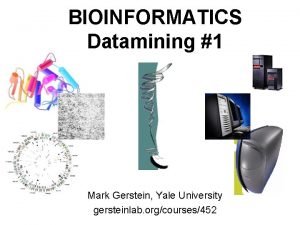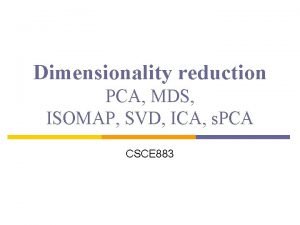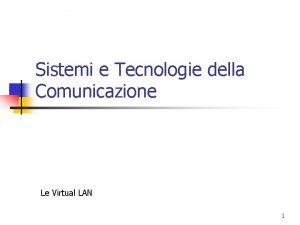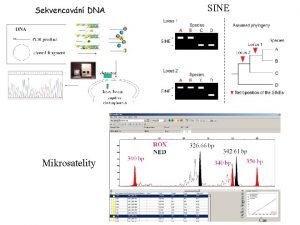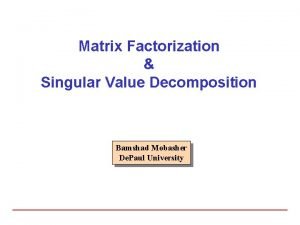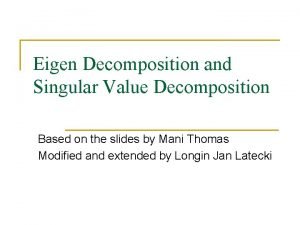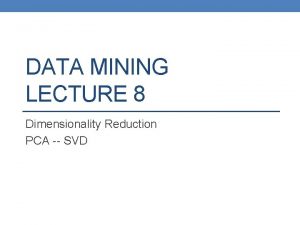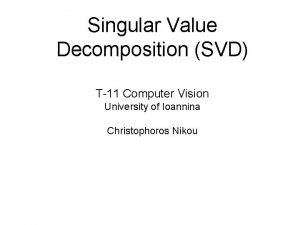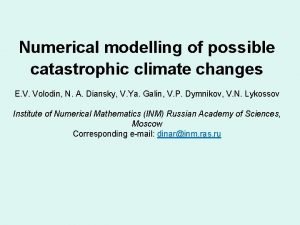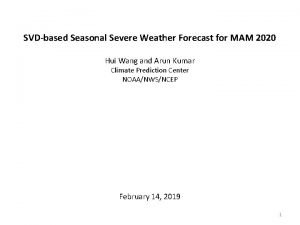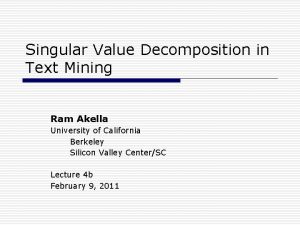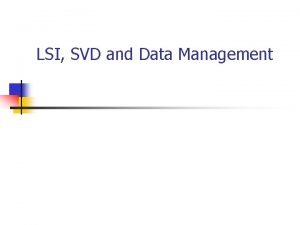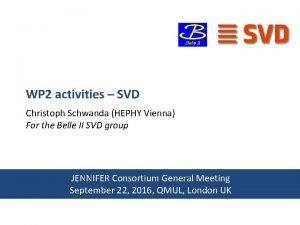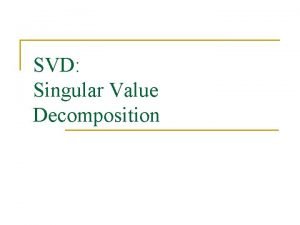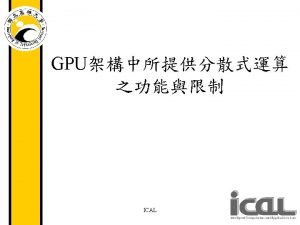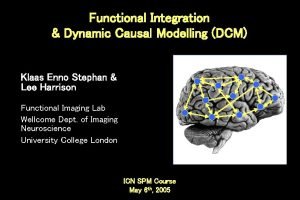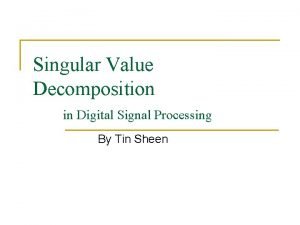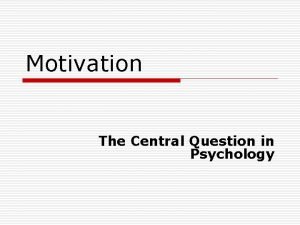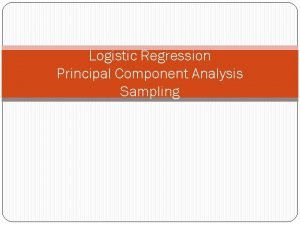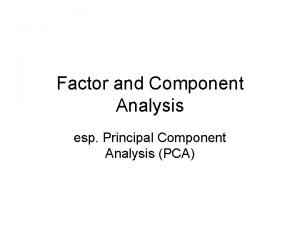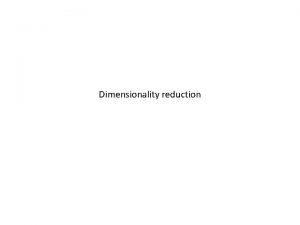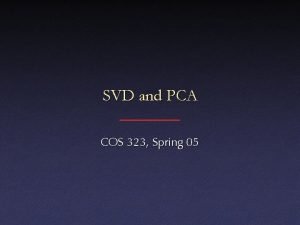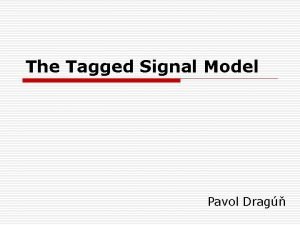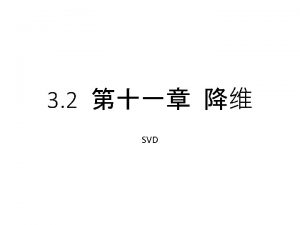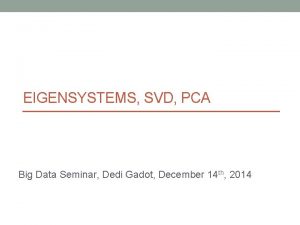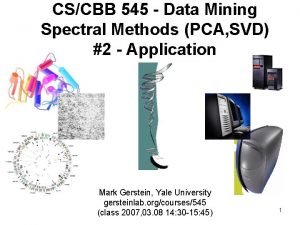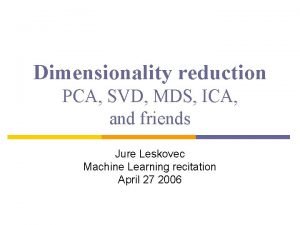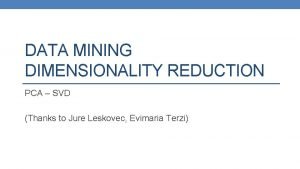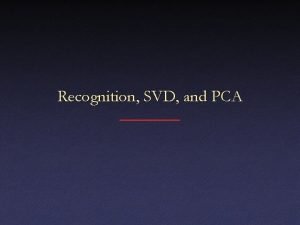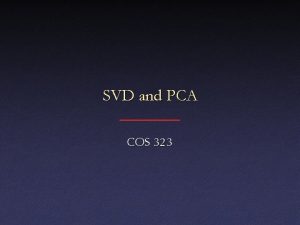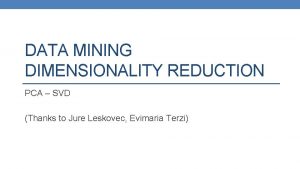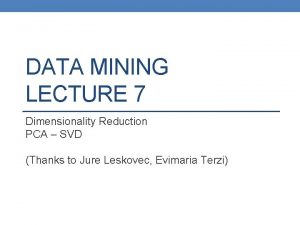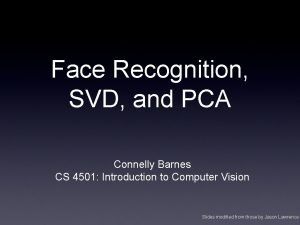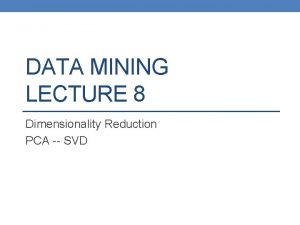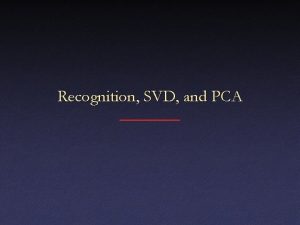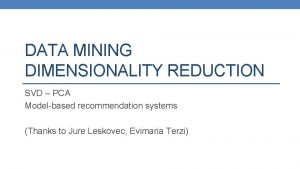PCA SVD Motivation Shape Matching There are tagged




















![Method 2: SVD Singular Value Decomposition [n×m] = [n×r] [r×m] r: rank of matrix Method 2: SVD Singular Value Decomposition [n×m] = [n×r] [r×m] r: rank of matrix](https://slidetodoc.com/presentation_image_h2/75ad8d6196ee79cb22f8494170a19239/image-21.jpg)










- Slides: 31

PCA + SVD

Motivation – Shape Matching There are tagged feature points in both sets that are matched by the user What is the best transformation that aligns the unicorn with the lion?

Motivation – Shape Matching Regard the shapes as sets of points and try to “match” these sets using a linear transformation The above is not a good alignment….

Motivation – Shape Matching � Alignment by translation or rotation ◦ The structure stays “rigid” under these two transformations �Called rigid-body or isometric (distance-preserving) transformations ◦ Mathematically, they are represented as matrix/vector operations Before alignment After alignment

Transformation Math � Translation ◦ Vector addition: � Rotation y ◦ Matrix product: x

Alignment � Input: two models represented as point sets ◦ Source and target � Output: locations of the translated and rotated source points Source Target

Alignment � Method 1: Principal component analysis (PCA) � Method 2: Singular value decomposition (SVD) � Method 3: Iterative closest point (ICP) ◦ Aligning principal directions ◦ Optimal alignment given prior knowledge of correspondence ◦ An iterative SVD algorithm that computes correspondences as it goes

Method 1: PCA � Compute a shape-aware coordinate system for each model ◦ Origin: Centroid of all points ◦ Axes: Directions in which the model varies most or least � Transform the source to align its origin/axes with the target

Method 1: PCA � Computing (PCA) axes: Principal Component Analysis ◦ Consider a set of points p 1, …, pn with centroid location c �Construct matrix P whose i-th column is vector pi – c � 2 D (2 by n): � 3 D (3 by n): �Build the covariance matrix: � 2 D: a 2 by 2 matrix � 3 D: a 3 by 3 matrix

Method 1: PCA � Computing axes: Principal Component Analysis (PCA) ◦ Eigenvectors of the covariance matrix represent principal directions of shape variation (2 in 2 D; 3 in 3 D) �The eigenvectors are orthogonal, and have no magnitude; only directions ◦ Eigenvalues indicate amount of variation along each eigenvector �Eigenvector with largest (smallest) eigenvalue is the direction where the model shape varies the most (least) Eigenvector with the smallest eigenvalue Eigenvector with the largest eigenvalue

Method 1: PCA Why do we look at the singular vectors? On the board… Input: 2 -d dimensional points 2 nd (right) singular vector 1 st (right) singular vector Output: 1 st (right) singular vector: direction of maximal variance, 2 nd (right) singular vector: direction of maximal variance, after removing the projection of the data along the first singular vector.

Method 1: PCA Covariance matrix �

Method 1: PCA �

Method 1: PCA Input: 2 -d dimensional points Output: 2 nd (right) singular vector 1 st (right) singular vector: direction of maximal variance, 2 nd (right) singular vector: direction of maximal variance, after removing the projection of the data along the first singular vector.

Method 1: PCA Singular values 2 nd (right) singular vector 1: measures how much of the data variance is explained by the first singular vector. 1 1 st (right) singular vector 2: measures how much of the data variance is explained by the second singular vector.

Method 1: PCA Singular values tell us something about the variance � The variance in the direction of the k-th principal component is given by the corresponding singular value σk 2 � Singular values can be used to estimate how many components to keep � Rule of thumb: keep enough to explain 85% of the variation:

Method 1: PCA Another property of PCA � The chosen vectors are such that minimize the sum of square differences between the data vectors and the lowdimensional projections 1 st (right) singular vector

Method 1: PCA � Limitations ◦ Centroid and axes are affected by noise Noise Axes are affected PCA result

Method 1: PCA � Limitations ◦ Axes can be unreliable for circular objects �Eigenvalues become similar, and eigenvectors become unstable Rotation by a small angle PCA result

Method 2: SVD � Optimal points alignment between corresponding ◦ Assuming that for each source point, we know where the corresponding target point is.
![Method 2 SVD Singular Value Decomposition nm nr rm r rank of matrix Method 2: SVD Singular Value Decomposition [n×m] = [n×r] [r×m] r: rank of matrix](https://slidetodoc.com/presentation_image_h2/75ad8d6196ee79cb22f8494170a19239/image-21.jpg)
Method 2: SVD Singular Value Decomposition [n×m] = [n×r] [r×m] r: rank of matrix A U, V are orthogonal matrices

Method 2: SVD � Formulating the problem ◦ Source points p 1, …, pn with centroid location c. S ◦ Target points q 1, …, qn with centroid location c. T �qi is the corresponding point of pi ◦ After centroid alignment and rotation by some R, a transformed source point is located at: ◦ We wish to find the R that minimizes sum of pairwise distances: � Solving the problem – on the board…

Method 2: SVD � SVD-based alignment: summary ◦ Forming the cross-covariance matrix ◦ Computing SVD ◦ The optimal rotation matrix is Translate ◦ Translate and rotate the source: Rotate

Method 2: SVD � Advantage over PCA: more stable ◦ As long as the correspondences are correct

Method 2: SVD � Advantage over PCA: more stable ◦ As long as the correspondences are correct

Method 2: SVD � Limitation: requires accurate correspondences ◦ Which are usually not available

Method 3: ICP � The idea ◦ Use PCA alignment to obtain initial guess of correspondences ◦ Iteratively improve the correspondences after repeated SVD � Iterative closest point (ICP) ◦ 1. Transform the source by PCA-based alignment ◦ 2. For each transformed source point, assign the closest target point as its corresponding point. Align source and target by SVD. �Not all target points need to be used ◦ 3. Repeat step (2) until a termination criteria is met.

ICP Algorithm After PCA After 1 iter After 10 iter

ICP Algorithm After PCA After 1 iter After 10 iter

ICP Algorithm � Termination criteria ◦ A user-given maximum iteration is reached ◦ The improvement of fitting is small �Root Mean Squared Distance (RMSD): �Captures average deviation in all corresponding pairs �Stops the iteration if the difference in RMSD before and after each iteration falls beneath a user-given threshold

More Examples After PCA After ICP
 Mark gerstein
Mark gerstein Isomap matlab
Isomap matlab Mikael ferm
Mikael ferm Shape matching and object recognition using shape contexts
Shape matching and object recognition using shape contexts Bolongie
Bolongie Vlan tagged e untagged
Vlan tagged e untagged Untagged vs tagged vlan
Untagged vs tagged vlan Virtual lan
Virtual lan Tagged polymer
Tagged polymer Matrix factorization
Matrix factorization Eigendecomposition
Eigendecomposition Svd
Svd Svd computer vision
Svd computer vision Svd
Svd Svd data mining
Svd data mining Svd
Svd Svd text mining
Svd text mining Svd
Svd Svd
Svd Svd nedir
Svd nedir Full rank
Full rank Rbg pixel
Rbg pixel Svd
Svd Svd
Svd Svd
Svd Types of motivation
Types of motivation Aerodynamic shape vs aerofoil shape
Aerodynamic shape vs aerofoil shape Pca logistic regression
Pca logistic regression 21w12
21w12 Kjersti johnson
Kjersti johnson Pca observation chart
Pca observation chart Covariance pca
Covariance pca
